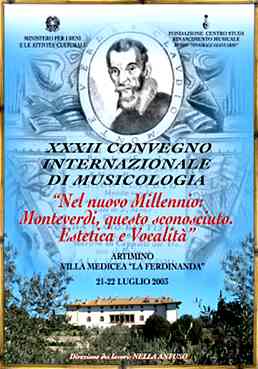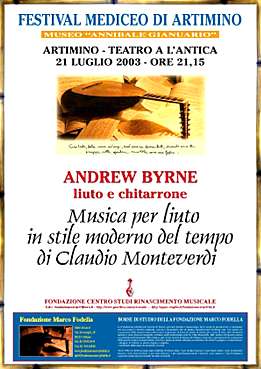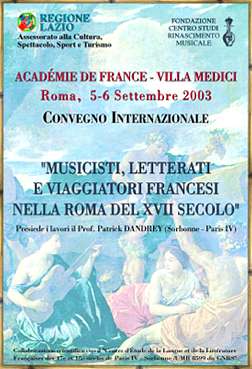|
 In
1969,well before and independently of that which will constitute the
fashion of “early music”, a few experts and musicians founded on the
30th of June in Florence, city of the official residence, at the
notary’s office in Florence, the CENTRO STUDI RINASCIMENTO MUSICALE. In
1969,well before and independently of that which will constitute the
fashion of “early music”, a few experts and musicians founded on the
30th of June in Florence, city of the official residence, at the
notary’s office in Florence, the CENTRO STUDI RINASCIMENTO MUSICALE.
This CENTRE made the scope to study with close examination the
great Renaissance period of our civilization both from a theoretical
and practical point of view, with a special reference to the period
of the efflorescence of which we can define the “Humanistic Song” that,
from the Platonic recuperation thanks to the work of Ficino in the
Florence of four-hundred, conduces to the realization of the “poetic
Song” in the classic sense in Florence and all of Italy between the XVI
and the beginning XVII century.
The
activity of the CSRM took place in many sectors:
 |
the historical and
musicological research; |
 |
the close
examination of the aesthetics and philosophy; |
 |
the transcription
and publication of unpublished music; |
 |
the specific study
of Vocal Art and study of musical instruments; |
 |
the organization
at a Round Table and International conventions on Musicology; |
 |
the organization
of seasonal concerts for the presentation in the first modern
performance of unpublished music, above all vocal; |
 |
the organization
of seminars of Vocal Master classes. |
The
concert activities had occurred in the most prestigious places in
Florence: from the Museo del Bargello in Palazzo Davanzati, from Palazzo
Vecchio to Palazzo Pitti, to the Florentine Churches most antique (with
historical Organs of immense value) like S. Trinità and the Badia
Fiorentina. The cultural activity (International Conventions of
Musicology and Master classes) had as there official residence both the
Villa Medicea “La Ferdinanda” of Artimino, where immediately
after its constitution, the CSRM had its official residence, and also
the Villa Medicea of Poggio a Caiano, both situated in Carmignano,
a zone very rich of Etruscan artefacts and a famous wine, a few
kilometres from Florence, Prato and Vinci.
The first publication of the CRSM dates back to 1969 and regards the
first modern original edition of the Unicum in the Venetian
edition in 1623 of Arianna by Claudio Monteverdi.
The editorial Corpus comprises up to about fifty publications to date,
of which a few depleted.
The first international Convention on Musicology dates back to
1971 and is an annual event continuous today. To these conventions have
participated the most illustrious experts originated from the 5
continents: Jacques Chailley (Sorbonne), Claude Palisca (Yale
University), David Galliver (Adelaide University) and our own
famous Nino Pirrotta (Harvard University and Rome University).
The first seasonal concert dates back also to 1971 so as the
annual Vocal Master classes on the Monody of the XVI – XVII centuries.
 The
president of the CSRM since the beginning has been Prof. Annibale
GIANUARIO, the most important Monteverdian expert in our time,
expert without equals in the poetic-musical aesthetics of the Humanistic
Song in the Renaissance period. Prof. Gianuario has been elected again
to hold the presidency until the year of his death in May 1991. The
president of the CSRM since the beginning has been Prof. Annibale
GIANUARIO, the most important Monteverdian expert in our time,
expert without equals in the poetic-musical aesthetics of the Humanistic
Song in the Renaissance period. Prof. Gianuario has been elected again
to hold the presidency until the year of his death in May 1991.
He has therefore guided the CSRM lavishing physical and spiritual
energies, and also a good quantity of personal money, until the
transformation of the CSRM in “Foundation” in 1992, when the presidency
was assumed by Dr. Nella Anfuso, already founder of the CSRM and
collaborator with Prof. Gianuario.
This activity for both has been a result of pure and disinterested
research, far away from the fashions, in Musical Art of the
greatest and complete period of the Italian civilization.
One of
the merits in the activities of the CSRM in place, as
indisputable target and unanimously recognized all over the world,
are in particular:
 |
the discovery
of the Platonic essence of the aesthetics by the Florentine
Camerata of Bardi’s House, of Monteverdi, of Italian authors,
above all Tuscans, and the production of the “representative
style” in the beginning of Six-hundred; |
 |
the different
definitions of the “Operatic style”; |
 |
the
recuperation of the Italian School of Song in the golden age
(XV-XVIII century); |
 |
the proposition
again in world première of the different
performing styles that characterized more than four centuries of
Italian Vocalism; |
 |
the close
examination with regards to the authenticity of the
“Incoronazione di Poppea” attributed falsely to Claudio
Monteverdi. |
These are innovations
recognized and appreciated all over the world. |
